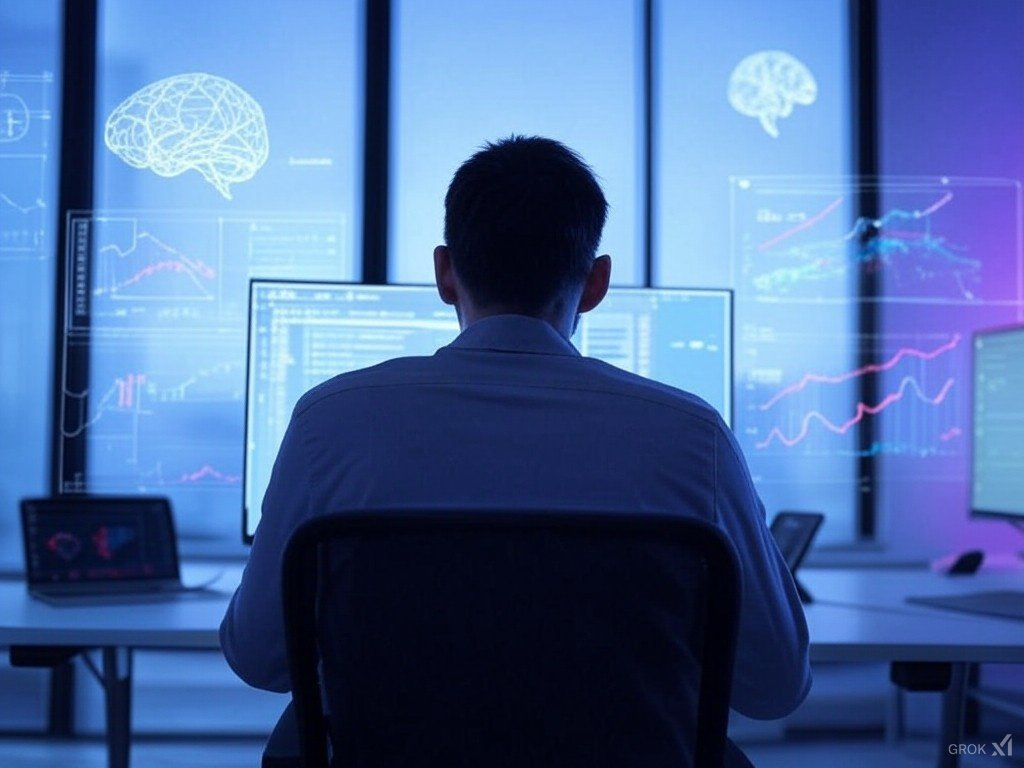How to use AI in Digital Marketing.
Key Takeaways
AI’s current role centres on native ad platform features like automated bidding, audience segmentation and dynamic creative, as well as tools for generating copy, images, video and voiceovers.
Although AI speeds up production and enables personalisation at scale, human oversight is vital for strategic direction, storytelling, brand tone and ethical compliance.
Future developments include predictive analytics, hyper‑personalisation and advanced chatbots; brands should adopt AI incrementally, integrate it into workflows and maintain a human‑in‑the‑loop for quality and authenticity.
Artificial Intelligence (AI) has become a hot topic in virtually every industry, and digital marketing is no exception. Still, if you look under the hood of most marketing operations today, you’ll find that true AI integration—beyond what major ad platforms offer for optimizing ad placements—is quite limited. As of this writing, AI in digital marketing is primarily confined to:
Native AI within advertising platforms (Meta Ads, Google Ads, etc.), which helps automate and optimize campaign performance.
Content creation tools that leverage AI for copywriting, blog drafting, image and video generation, and even AI-driven voiceovers.
In this blog, we’ll explore the real-world applications of AI in digital marketing, what’s currently possible, and where the industry is likely headed. We’ll also discuss how to combine AI’s capabilities with human oversight to achieve the best results.
How to use AI in Digital Marketing.
1. AI in Advertising Platforms
1.1 How Platforms Like Meta and Google Use AI
Automated Bidding and Budget Allocation:
Platforms like Meta and Google rely on machine learning algorithms to place ads in front of the right audience at the right time. Advertisers set their objectives (e.g., maximizing conversions or clicks), and the platform automatically adjusts bids based on real-time data.Audience Targeting and Segmentation:
AI helps identify micro-segments within your broader audience. For example, Meta’s lookalike audiences or Google’s custom intent audiences allow advertisers to reach users most similar to existing customers, thereby increasing the likelihood of conversions.Ad Creative and Format Optimization:
AI-driven algorithms can test different ad variations—headlines, images, calls to action (CTAs), and even colors—to find the best-performing combination. The goal is to lower the cost per acquisition (CPA) and improve Return on Ad Spend (ROAS).
1.2 Limitations of Platform-Based AI
Despite these impressive capabilities, the native AI in Meta and Google Ads is often limited to specific tasks like real-time bidding and automated creative testing. The strategic, big-picture decisions—such as brand positioning, messaging tone, and campaign goals—still require human marketers. Moreover, these tools won’t craft new marketing concepts from scratch. They excel at incremental optimizations rather than broader, creative direction.
2. AI for Content Creation
2.1 AI-Generated Copywriting
Perhaps the most transformative application of AI in digital marketing today is content creation. Tools like ChatGPTand other large language models have made it easier and faster to generate:
Marketing copy for ads, social posts, emails, and landing pages
Long-form articles, blog posts, and whitepapers
Product descriptions and category pages for e-commerce sites
Why It Matters:
Speed and Scalability: AI can draft a 1,000-word article in seconds, significantly cutting down content production times.
Ideation Support: Marketers can rapidly brainstorm angles and topics, letting AI propose outlines or titles that spark further creativity.
Important Caveat:
While AI can handle much of the legwork, human oversight is essential. AI-generated text may contain inaccuracies, generic fluff, or fail to fully capture a brand’s voice. Marketers, editors, and subject-matter experts should refine AI-generated drafts to ensure factual correctness, style consistency, and brand alignment.
2.2 AI-Generated Imagery and Video
Beyond text, AI-powered tools like Sora (and others such as Midjourney, DALL·E, and Stable Diffusion) can generate:
Custom product images
Unique background visuals
Short video clips or animations
Benefits:
Creative Freedom: Marketers can visualize ideas without hiring an entire creative team or orchestrating a full-blown photoshoot.
Personalization at Scale: AI can generate multiple on-brand variations, allowing marketers to quickly A/B test visuals.
Challenges:
Quality Control: AI may create images or videos that look synthetic or off-brand if not guided properly.
Ethical and Licensing Concerns: Marketers must ensure they have the rights to use AI-generated assets and remain transparent if the tool references copyrighted material.
2.3 AI-Driven Voiceovers
AI-powered text-to-speech generators can now create lifelike voiceovers for ads, explainer videos, and e-learning content. This offers:
Cost-Effectiveness: No need to hire voice actors for every single recording.
Language Variations: Quickly localize and translate voiceovers to different languages.
Fast Iterations: Swiftly update scripts and re-generate audio with minimal fuss.
3. Why Human Expertise Still Matters
While AI excels at pattern recognition, predictive modelling, and rapid content generation, it’s still largely dependent on human input for strategic vision and brand authenticity. Here’s why:
Nuanced Brand Messaging: Brands aren’t just about keywords and templates. They need emotional resonance, storytelling, and empathy—qualities that require human creativity and cultural awareness.
Contextual and Ethical Judgment: AI might inadvertently produce insensitive or misleading content. A human review process is crucial to maintain ethical standards and brand safety.
Deep Subject Matter Expertise: AI language models can hallucinate facts or produce generic text. A subject matter expert ensures content remains accurate and authoritative.
Adaptability to Changing Trends: AI models learn from historical data; they can struggle with real-time adaptability for breaking news, evolving cultural dialogues, or sudden shifts in consumer behaviour.
4. Future Prospects of AI in Digital Marketing
Despite AI’s current limitations, the technology is evolving at a rapid pace. Here are a few areas where it might become more robust:
Predictive Analytics:
Tools could predict changes in consumer demand or seasonality with greater accuracy, helping marketers optimize budgets ahead of time.
Hyper-Personalization:
AI might refine website and email personalization for each unique visitor, adjusting everything from layout to recommended content in real-time.
Advanced Chatbots and Virtual Assistants:
Future chatbots may handle more complex customer service queries, even guiding users through multi-step processes.
Real-Time Campaign Adaptation:
AI could proactively reshape campaign strategies on the fly based on external factors such as competitor moves, weather changes, or market fluctuations.
End-to-End Creative Direction:
Possibly, AI could brainstorm entire multi-channel campaigns, from concept to final visual assets—though true creative genius is still more likely to come from human insight and emotion.
5. How Brands Can Use AI Today to Boost Digital Marketing
5.1 Start with Incremental Improvements
Use Native Platform AI Smartly:
Optimize your Meta or Google Ads by leveraging automated bidding and dynamic creative. Monitor results closely to ensure campaigns meet ROI targets.Enhance Copy with AI:
Generate a first draft of blog posts or social media content. Focus human efforts on refinement, fact-checking, and brand voice calibration.Create Prototype Imagery or Concepts:
Let AI generate multiple creative options for a campaign pitch. Test these concepts with real audiences and refine.
5.2 Integrate AI in Your Workflow
Content Calendar Planning:
AI tools can suggest trending topics or SEO-friendly keywords, helping you plan a content calendar efficiently.Automate Repetitive Tasks:
AI can handle tasks like sorting leads, tagging email contacts, or analyzing large sets of data (e.g., user behaviour metrics).Personalize Customer Touchpoints:
Whether it’s recommending products or tailoring email subjects, AI can segment audiences in real time for hyper-personalized marketing.
5.3 Maintain Quality and Authenticity
Human-in-the-Loop:
Ensure that at every critical juncture—be it ad creation, content publishing, or brand messaging—human oversight is present.Adhere to Ethical Standards:
Be transparent about AI-generated content where appropriate and ensure you follow any legal guidelines related to AI usage and consumer data privacy.
6. Key Takeaways
AI’s Core Role Right Now:
Advertising Optimization: Native AI features in major ad platforms.
Content Generation: Blogs, social posts, copywriting, image, and video creation.
Human Creativity Is Irreplaceable:
AI lacks emotional intelligence and brand storytelling finesse.
Experts must oversee and refine AI-generated outputs.
Current Limitations:
True “end-to-end” AI marketing suites are still in development.
Advanced AI solutions for strategy, cultural context, or deep brand alignment remain limited.
Future Is Bright—but Requires Balance:
More sophisticated AI tools will emerge, offering predictive analytics and deeper personalization.
Human guidance will remain crucial for ethical, culturally sensitive, and brand-consistent marketing.
Conclusion
AI has indeed made substantial inroads into digital marketing, primarily through ad platform algorithms and content creation tools. While these technologies are already good—and only getting better—marketing professionals still play the central role in shaping brand strategy, ensuring factual accuracy, and preserving a unique voice that resonates with real people.
For most businesses, the best approach right now is to blend AI’s strengths (speed, scalability, analytics) with human expertise (creativity, empathy, ethical judgment). As AI continues to evolve, those who master this balance will be positioned to innovate quickly, optimize effectively, and create impactful campaigns that stand out in an increasingly automated world.












